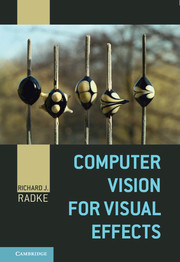Book contents
8 - Three-Dimensional Data Acquisition
Published online by Cambridge University Press: 05 December 2012
Summary
A key responsibility of a visual effects supervisor on a movie set is to collect three-dimensional measurements of structures, since the set may be broken down quickly after filming is complete. These measurements are critical for guiding the later insertion of 3D computer-generated elements. In this chapter, we focus on the most common tools and techniques for acquiring accurate 3D data.
Visual effects personnel use several of the same tools as professional surveyors to acquire 3D measurements. For example, to acquire accurate distances to a small set of 3D points, they may use a total station. The user centers the scene point to be measured in the crosshairs of a telescope-like sight, and the two spherical angles defining the heading are electronically measured with high accuracy. Then an electronic distance measuring device uses the time of flight of an infrared or microwave beam that reflects off of the scene point to accurately determine the distance to the target. However, acquiring more than a few 3D distance measurements in this way is tedious and time-consuming.
It's recently become common to automatically survey entire filming locations using laser range-finding techniques, which we discuss in Section 8.1. The result is a cloud of hundreds of thousands of 3D points visible along lines of sight emanating from the laser scanner. These techniques, collectively called Light Detection and Ranging or LiDAR, are highly accurate and allow the scanning of objects tens to hundreds of meters away.
- Type
- Chapter
- Information
- Computer Vision for Visual Effects , pp. 300 - 352Publisher: Cambridge University PressPrint publication year: 2012



